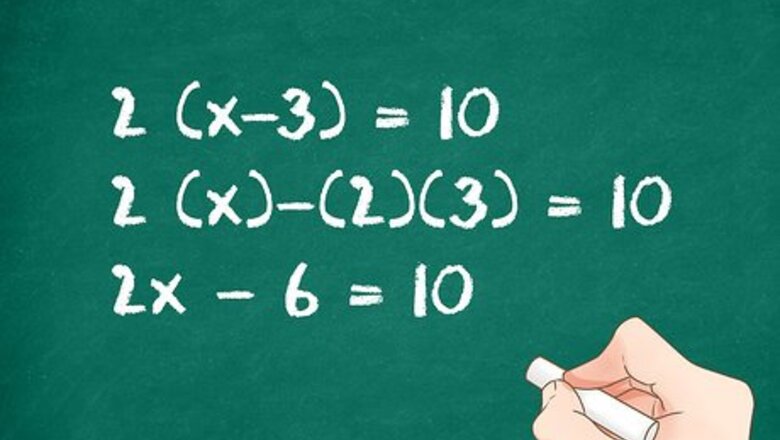
views
Using the Basic Distributive Property
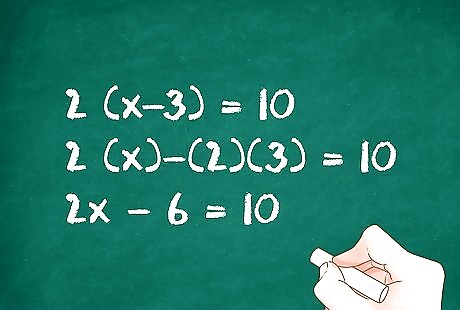
Multiply the term outside of the parentheses by each term in the parentheses. To do this, you are essentially distributing the outer term into the inner terms. Multiply the term outside the parentheses by the first term in the parentheses. Then multiply it by the second term. If there are more than two terms, keep distributing the term until there are no terms left. Keep whatever operation (plus or minus) is in the parentheses. 2 ( x − 3 ) = 10 {\displaystyle 2(x-3)=10} 2(x-3)=10 2 ( x ) − ( 2 ) ( 3 ) = 10 {\displaystyle 2(x)-(2)(3)=10} 2(x)-(2)(3)=10 2 x − 6 = 10 {\displaystyle 2x-6=10} 2x-6=10
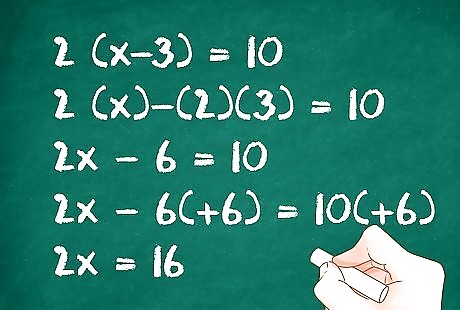
Combine like terms. Before you can solve the equation, you will have to combine like terms. Combine all numerical terms with each other. Separately, combine any variable terms. To simplify the equation, arrange the terms so the variables are on one side of the equals sign and the constants (numbers only) are on the other. 2 x − 6 = 10 {\displaystyle 2x-6=10} 2x-6=10…..(original problem) 2 x − 6 ( + 6 ) = 10 ( + 6 ) {\displaystyle 2x-6(+6)=10(+6)} 2x-6(+6)=10(+6)….. (Add 6 to both sides) 2 x = 16 {\displaystyle 2x=16} 2x=16….. (Variable on left; constant on right)
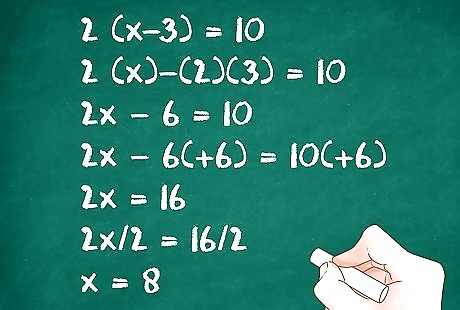
Solve the equation. Solve for x {\displaystyle x} x by dividing both sides of the equation by the coefficient in front of the variable. 2 x = 16 {\displaystyle 2x=16} 2x=16…..(original problem) 2 x / 2 = 16 / 2 {\displaystyle 2x/2=16/2} 2x/2=16/2…..(divide both sides by 2) x = 8 {\displaystyle x=8} x=8…..(solution) EXPERT TIP Joseph Meyer Joseph Meyer Math Teacher Joseph Meyer is a High School Math Teacher based in Pittsburgh, Pennsylvania. He is an educator at City Charter High School, where he has been teaching for over 7 years. Joseph is also the founder of Sandbox Math, an online learning community dedicated to helping students succeed in Algebra. His site is set apart by its focus on fostering genuine comprehension through step-by-step understanding (instead of just getting the correct final answer), enabling learners to identify and overcome misunderstandings and confidently take on any test they face. He received his MA in Physics from Case Western Reserve University and his BA in Physics from Baldwin Wallace University. Joseph Meyer Joseph Meyer Math Teacher The distributive property helps you avoid repetitive calculations. You can use the distributive property to solve equations where you must multiply a number by a sum or difference. It simplifies calculations, enables expression manipulation (like factoring), and forms the basis for solving many equations.
Distributing Negative Coefficients
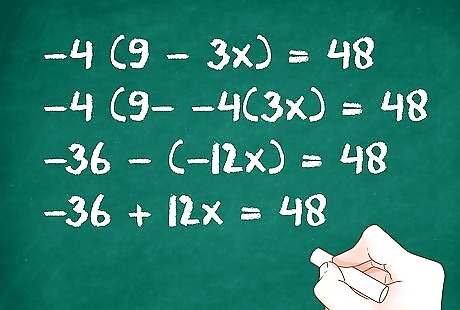
Distribute a negative number together with its negative sign. If you have a negative number multiplying a term or terms within parentheses, be sure to distribute the negative to each term inside the parentheses. Remember the basic rules of multiplying negatives: Neg. x Neg. = Pos. Neg. x Pos. = Neg. Consider the following example: − 4 ( 9 − 3 x ) = 48 {\displaystyle -4(9-3x)=48} -4(9-3x)=48….. (original problem) − 4 ( 9 ) − ( − 4 ) ( 3 x ) = 48 {\displaystyle -4(9)-(-4)(3x)=48} -4(9)-(-4)(3x)=48…..(distribute (-4) to each term) − 36 − ( − 12 x ) = 48 {\displaystyle -36-(-12x)=48} -36-(-12x)=48…..(simplify the multiplication) − 36 + 12 x = 48 {\displaystyle -36+12x=48} -36+12x=48…..(notice that ‘minus -12’ becomes +12)
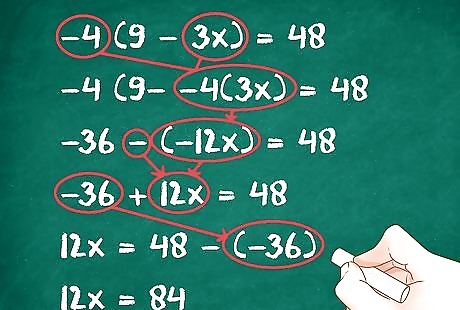
Combine like terms. After you complete the distribution, you then need to simplify the equation by moving all the variable terms to one side of the equals sign, and all the numbers without variables to the other. Do this by a combination of addition or subtraction. − 36 + 12 x = 48 {\displaystyle -36+12x=48} -36+12x=48…..(original problem) − 36 ( + 36 ) + 12 x = 48 + 36 {\displaystyle -36(+36)+12x=48+36} -36(+36)+12x=48+36…..(add 36 to each side) 12 x = 84 {\displaystyle 12x=84} 12x=84…..(simplify the addition to isolate the variable)

Divide to find the final solution. Solve the equation by dividing both sides of the equation by whatever the coefficient of the variable is. This should result in a single variable on one side of the equation, with the result on the other. 12 x = 84 {\displaystyle 12x=84} 12x=84…..(original problem) 12 x / 12 = 84 / 12 {\displaystyle 12x/12=84/12} 12x/12=84/12…..(divide both sides by 12) x = 7 {\displaystyle x=7} x=7…..(solution)
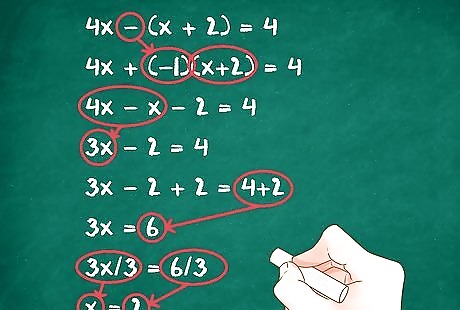
Treat subtraction as adding (-1). Whenever you see a minus sign in an algebra problem, particularly if it comes before a parenthesis, you should imagine that it says + (-1). This will help you correctly distribute the negative to all the terms within the parentheses. Then solve the problem as before. For example, consider the problem, 4 x − ( x + 2 ) = 4 {\displaystyle 4x-(x+2)=4} 4x-(x+2)=4. To be certain that you distribute the negative properly, rewrite the problem to read: 4 x + ( − 1 ) ( x + 2 ) = 4 {\displaystyle 4x+(-1)(x+2)=4} 4x+(-1)(x+2)=4 Then distribute the (-1) to the terms inside the parentheses as follows: 4 x + ( − 1 ) ( x + 2 ) = 4 {\displaystyle 4x+(-1)(x+2)=4} 4x+(-1)(x+2)=4…..(revised problem) 4 x − x − 2 = 4 {\displaystyle 4x-x-2=4} 4x-x-2=4…..(multiply (-1) times x and times 2) 3 x − 2 = 4 {\displaystyle 3x-2=4} 3x-2=4…..(combine terms) 3 x − 2 + 2 = 4 + 2 {\displaystyle 3x-2+2=4+2} 3x-2+2=4+2…..(add 2 to both sides) 3 x = 6 {\displaystyle 3x=6} 3x=6…..(simplify terms) 3 x / 3 = 6 / 3 {\displaystyle 3x/3=6/3} 3x/3=6/3…..(divide both sides by 3) x = 2 {\displaystyle x=2} x=2…..(solution)
Using the Distributive Property to Simplify Fractions
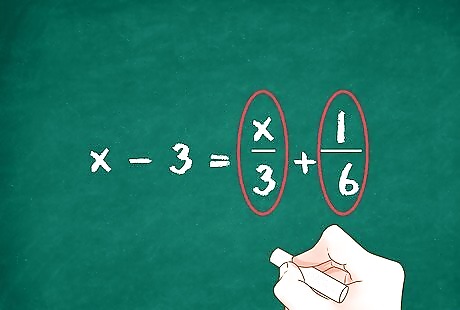
Identify any fractional coefficients or constants. Sometimes, you may have a problem that contains fractions as coefficients or constants. You are allowed to leave them as they are and apply the basic rules of algebra to solve the problem. However, using the distributive property can often simplify the solution by turning the fractions into integers. Consider the example x − 3 = x 3 + 1 6 {\displaystyle x-3={\frac {x}{3}}+{\frac {1}{6}}} x-3={\frac {x}{3}}+{\frac {1}{6}}. The fractions in this problem are x 3 {\displaystyle {\frac {x}{3}}} {\frac {x}{3}} and 1 6 {\displaystyle {\frac {1}{6}}} {\frac {1}{6}}.
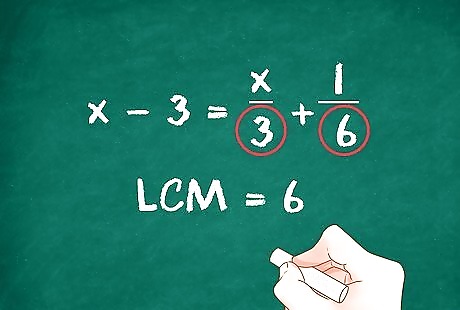
Find the lowest common multiple (LCM) for all denominators. For this step, you can ignore all the integers. Look only at the fractions, and find the LCM for all the denominators. To find the LCM, you need the smallest number that is evenly divisible by the denominators of the fractions in the equation. In this example, the denominators are 3 and 6, so the LCM is 6.
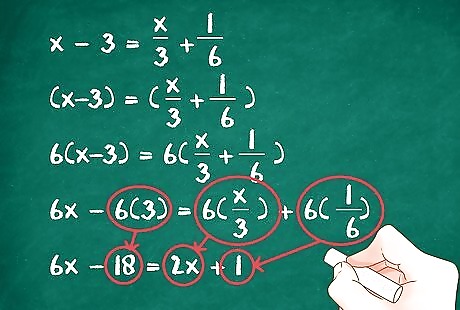
Multiply all terms of the equation by the LCM. Remember that you can perform any operation that you want to an algebra equation, as long as you do it equally to both sides. Multiply all terms of the equation by the LCM, and the fractions will cancel out and “become” integers. Place parentheses around the entire left and right sides of the equation and then perform the distribution: x − 3 = x 3 + 1 6 {\displaystyle x-3={\frac {x}{3}}+{\frac {1}{6}}} x-3={\frac {x}{3}}+{\frac {1}{6}}…..(original equation) ( x − 3 ) = ( x 3 + 1 6 ) {\displaystyle (x-3)=({\frac {x}{3}}+{\frac {1}{6}})} (x-3)=({\frac {x}{3}}+{\frac {1}{6}})…..(insert parentheses) 6 ( x − 3 ) = 6 ( x 3 + 1 6 ) {\displaystyle 6(x-3)=6({\frac {x}{3}}+{\frac {1}{6}})} 6(x-3)=6({\frac {x}{3}}+{\frac {1}{6}})…..(multiply both sides by LCM) 6 x − 6 ( 3 ) = 6 ( x 3 ) + 6 ( 1 6 ) {\displaystyle 6x-6(3)=6({\frac {x}{3}})+6({\frac {1}{6}})} 6x-6(3)=6({\frac {x}{3}})+6({\frac {1}{6}})…..(distribute multiplication) 6 x − 18 = 2 x + 1 {\displaystyle 6x-18=2x+1} 6x-18=2x+1…..(simplify multiplication)
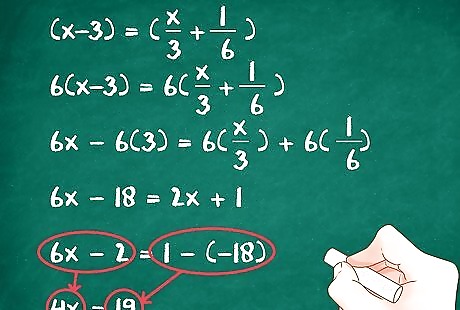
Combine like terms. Combine all of the terms so all the variables appear on one side of the equation, and all constants appear on the other. Use basic operations of addition and subtraction to move terms from one side to the other. 6 x − 18 = 2 x + 1 {\displaystyle 6x-18=2x+1} 6x-18=2x+1…..(simplified problem) 6 x − 2 x − 18 = 2 x − 2 x + 1 {\displaystyle 6x-2x-18=2x-2x+1} 6x-2x-18=2x-2x+1…..(subtract 2x from both sides) 4 x − 18 = 1 {\displaystyle 4x-18=1} 4x-18=1…..(simplify subtraction) 4 x − 18 + 18 = 1 + 18 {\displaystyle 4x-18+18=1+18} 4x-18+18=1+18…..(add 18 to both sides) 4 x = 19 {\displaystyle 4x=19} 4x=19…..(simplify addition)
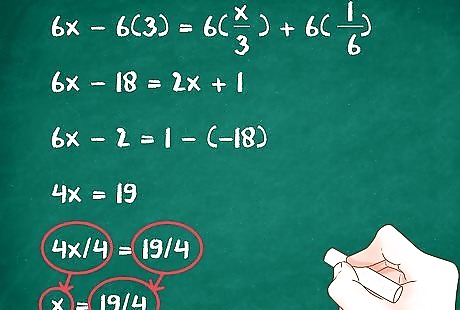
Solve the equation. Find the final solution by dividing both sides of the equation by the coefficient of the variable. This should leave a single x term on one side of the equation, and the numerical solution on the other. 4 x = 19 {\displaystyle 4x=19} 4x=19…..(revised problem) 4 x / 4 = 19 / 4 {\displaystyle 4x/4=19/4} 4x/4=19/4…..(divide both sides by 4) x = 19 4 or 4 3 4 {\displaystyle x={\frac {19}{4}}{\text{ or }}4{\frac {3}{4}}} x={\frac {19}{4}}{\text{ or }}4{\frac {3}{4}}…..(final solution)
Distributing a Long Fraction
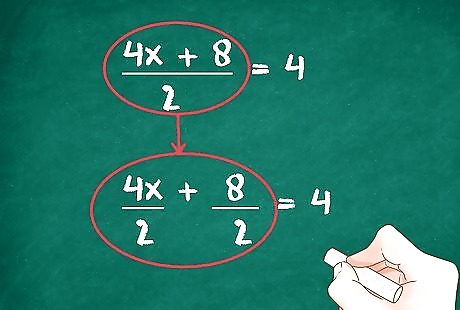
Interpret a long fraction as distributed division. You may occasionally see a problem that contains multiple terms in the numerator of a fraction, over a single denominator. You need to treat this as a distributive problem and apply the denominator to each term of the numerator. You can rewrite the fraction to show the distribution, as follows: 4 x + 8 2 = 4 {\displaystyle {\frac {4x+8}{2}}=4} {\frac {4x+8}{2}}=4.....(original problem) 4 x 2 + 8 2 = 4 {\displaystyle {\frac {4x}{2}}+{\frac {8}{2}}=4} {\frac {4x}{2}}+{\frac {8}{2}}=4.....(distribute the denominator to each term of the numerator)
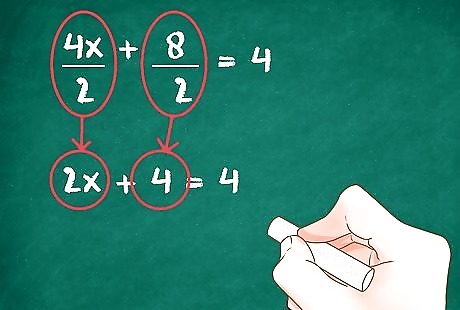
Simplify each numerator as a separate fraction. After distributing the denominator to each term, you can then simplify each term individually. 4 x 2 + 8 2 = 4 {\displaystyle {\frac {4x}{2}}+{\frac {8}{2}}=4} {\frac {4x}{2}}+{\frac {8}{2}}=4.....(revised problem) 2 x + 4 = 4 {\displaystyle 2x+4=4} 2x+4=4.....(simplify the fractions)
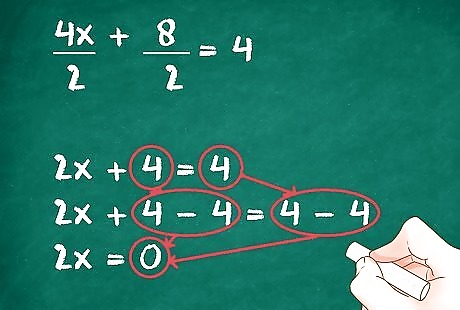
Isolate the variable. Proceed to solve the problem by isolating the variable on one side of the equation and moving the constant terms to the other side. Do this with a combination of addition and subtraction steps, as needed. 2 x + 4 = 4 {\displaystyle 2x+4=4} 2x+4=4.....(revised problem) 2 x + 4 − 4 = 4 − 4 {\displaystyle 2x+4-4=4-4} 2x+4-4=4-4.....(subtract 4 from both sides) 2 x = 0 {\displaystyle 2x=0} 2x=0.....(isolated x on one side)
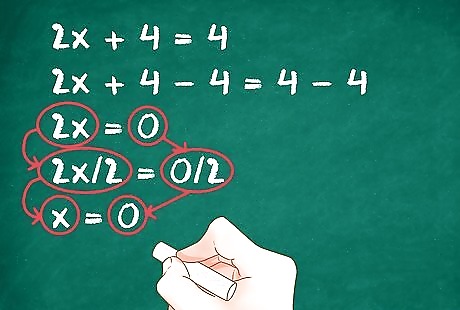
Divide by the coefficient to solve the problem. In the final step, divide by the coefficient of the variable. This should lead you to the final solution, with the single variable on one side of the equation and the numerical solution on the other. 2 x = 0 {\displaystyle 2x=0} 2x=0.....(revised problem) 2 x / 2 = 0 / 2 {\displaystyle 2x/2=0/2} 2x/2=0/2.....(divide both sides by 2) x = 0 {\displaystyle x=0} x=0.....(solution)
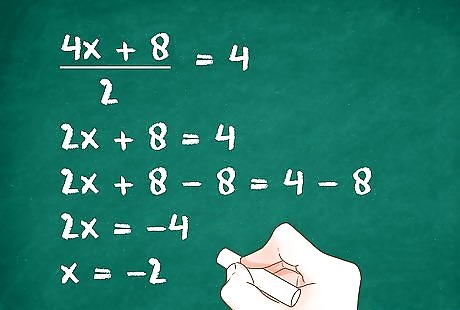
Avoid the common trap of dividing only one term. It is tempting (but incorrect) to divide the first numerator term by the denominator and cancel out the fraction. A mistake like this, for the problem above, would look like the following: 4 x + 8 2 = 4 {\displaystyle {\frac {4x+8}{2}}=4} {\frac {4x+8}{2}}=4.....(original problem) 2 x + 8 = 4 {\displaystyle 2x+8=4} 2x+8=4.....(divide only 4x by 2 instead of the full numerator) 2 x + 8 − 8 = 4 − 8 {\displaystyle 2x+8-8=4-8} 2x+8-8=4-8 2 x = − 4 {\displaystyle 2x=-4} 2x=-4 x = − 2 {\displaystyle x=-2} x=-2..... (incorrect solution)

Check the correctness of your solution. You can always check your work by inserting your solution into the original problem. When you simplify, you should reach a true statement. If you simplify and get an incorrect statement, then your solution was incorrect. For this example, test the two solutions of x=0 and x=-2 to see which is correct. Begin with the solution x=0: 4 x + 8 2 = 4 {\displaystyle {\frac {4x+8}{2}}=4} {\frac {4x+8}{2}}=4.....(original problem) 4 ( 0 ) + 8 2 = 4 {\displaystyle {\frac {4(0)+8}{2}}=4} {\frac {4(0)+8}{2}}=4.....(insert 0 for x) 0 + 8 2 = 4 {\displaystyle {\frac {0+8}{2}}=4} {\frac {0+8}{2}}=4 8 2 = 4 {\displaystyle {\frac {8}{2}}=4} {\frac {8}{2}}=4 4 = 4 {\displaystyle 4=4} 4=4.....(true statement. This is the correct solution.) Try the "false" solution of x=-2: 4 x + 8 2 = 4 {\displaystyle {\frac {4x+8}{2}}=4} {\frac {4x+8}{2}}=4.....(original problem) 4 ( − 2 ) + 8 2 = 4 {\displaystyle {\frac {4(-2)+8}{2}}=4} {\frac {4(-2)+8}{2}}=4.....(insert -2 for x) − 8 + 8 2 = 4 {\displaystyle {\frac {-8+8}{2}}=4} {\frac {-8+8}{2}}=4 0 2 = 4 {\displaystyle {\frac {0}{2}}=4} {\frac {0}{2}}=4 0 = 4 {\displaystyle 0=4} 0=4.....(incorrect statement. Therefore, x=-2 is false.)




















Comments
0 comment